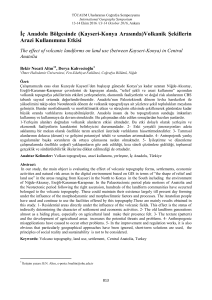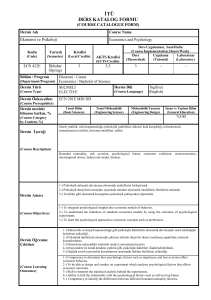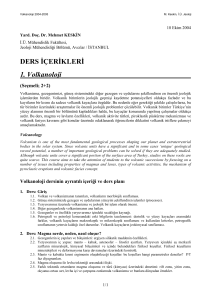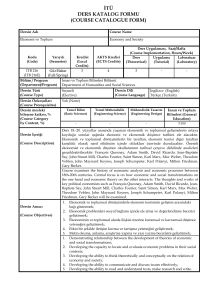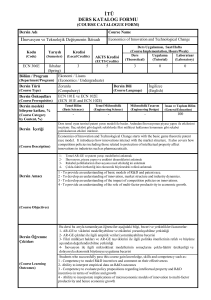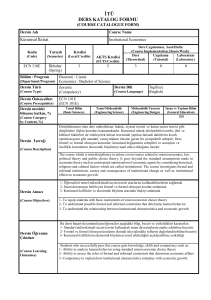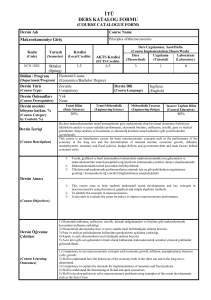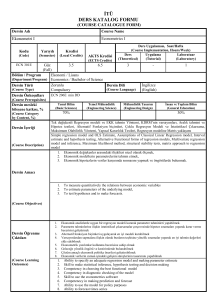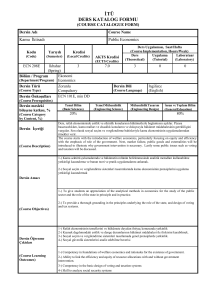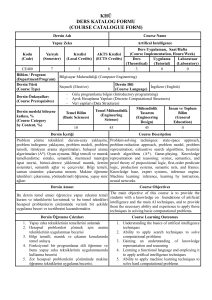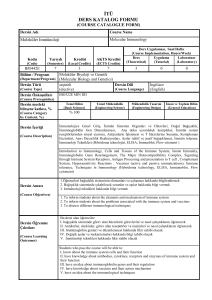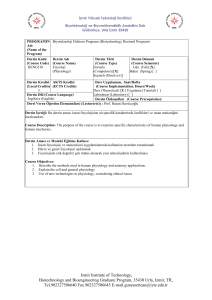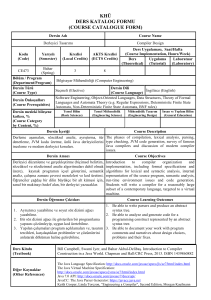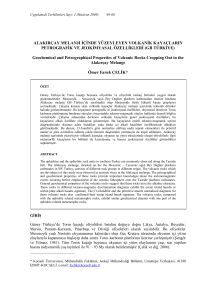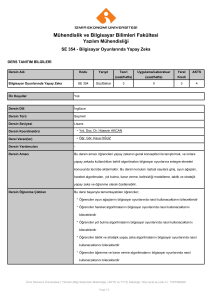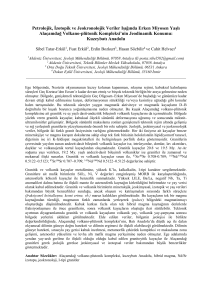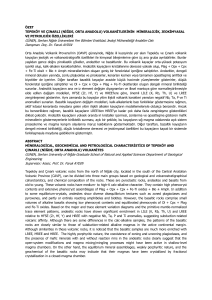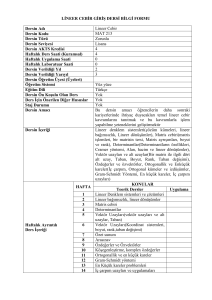İTÜ DERS KATALOG FORMU
advertisement
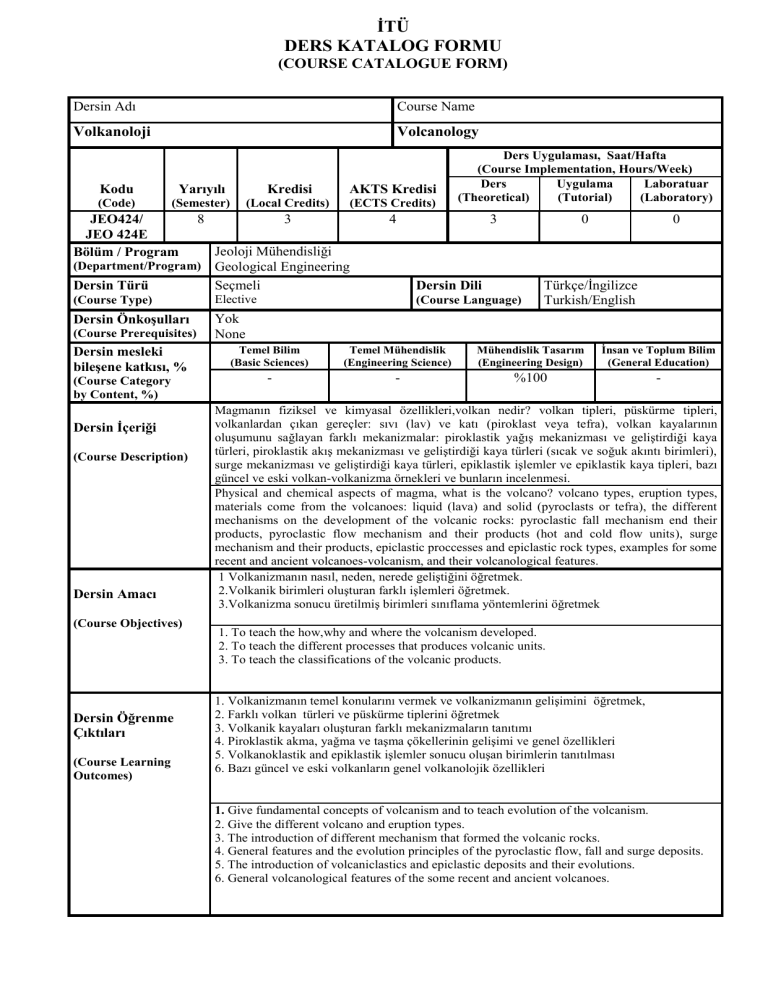
İTÜ DERS KATALOG FORMU (COURSE CATALOGUE FORM) Dersin Adı Course Name Volkanoloji Volcanology Kodu Yarıyılı Kredisi AKTS Kredisi (Code) (Semester) (Local Credits) (ECTS Credits) 8 3 4 JEO424/ JEO 424E Bölüm / Program Ders Uygulaması, Saat/Hafta (Course Implementation, Hours/Week) Ders Uygulama Laboratuar (Theoretical) (Tutorial) (Laboratory) 3 0 Dersin Türü Jeoloji Mühendisliği Geological Engineering Seçmeli Dersin Dili (Course Type) Elective (Course Language) Dersin Önkoşulları Yok None (Department/Program) (Course Prerequisites) Dersin mesleki bileşene katkısı, % (Course Category by Content, %) Dersin İçeriği (Course Description) Dersin Amacı (Course Objectives) Dersin Öğrenme Çıktıları (Course Learning Outcomes) 0 Türkçe/İngilizce Turkish/English Temel Bilim (Basic Sciences) Temel Mühendislik (Engineering Science) Mühendislik Tasarım (Engineering Design) İnsan ve Toplum Bilim (General Education) - - %100 - Magmanın fiziksel ve kimyasal özellikleri,volkan nedir? volkan tipleri, püskürme tipleri, volkanlardan çıkan gereçler: sıvı (lav) ve katı (piroklast veya tefra), volkan kayalarının oluşumunu sağlayan farklı mekanizmalar: piroklastik yağış mekanizması ve geliştirdiği kaya türleri, piroklastik akış mekanizması ve geliştirdiği kaya türleri (sıcak ve soğuk akıntı birimleri), surge mekanizması ve geliştirdiği kaya türleri, epiklastik işlemler ve epiklastik kaya tipleri, bazı güncel ve eski volkan-volkanizma örnekleri ve bunların incelenmesi. Physical and chemical aspects of magma, what is the volcano? volcano types, eruption types, materials come from the volcanoes: liquid (lava) and solid (pyroclasts or tefra), the different mechanisms on the development of the volcanic rocks: pyroclastic fall mechanism end their products, pyroclastic flow mechanism and their products (hot and cold flow units), surge mechanism and their products, epiclastic proccesses and epiclastic rock types, examples for some recent and ancient volcanoes-volcanism, and their volcanological features. 1 Volkanizmanın nasıl, neden, nerede geliştiğini öğretmek. 2.Volkanik birimleri oluşturan farklı işlemleri öğretmek. 3.Volkanizma sonucu üretilmiş birimleri sınıflama yöntemlerini öğretmek 1. To teach the how,why and where the volcanism developed. 2. To teach the different processes that produces volcanic units. 3. To teach the classifications of the volcanic products. 1. Volkanizmanın temel konularını vermek ve volkanizmanın gelişimini öğretmek, 2. Farklı volkan türleri ve püskürme tiplerini öğretmek 3. Volkanik kayaları oluşturan farklı mekanizmaların tanıtımı 4. Piroklastik akma, yağma ve taşma çökellerinin gelişimi ve genel özellikleri 5. Volkanoklastik and epiklastik işlemler sonucu oluşan birimlerin tanıtılması 6. Bazı güncel ve eski volkanların genel volkanolojik özellikleri 1. Give fundamental concepts of volcanism and to teach evolution of the volcanism. 2. Give the different volcano and eruption types. 3. The introduction of different mechanism that formed the volcanic rocks. 4. General features and the evolution principles of the pyroclastic flow, fall and surge deposits. 5. The introduction of volcaniclastics and epiclastic deposits and their evolutions. 6. General volcanological features of the some recent and ancient volcanoes. Ders Kitabı (Textbook) Diğer Kaynaklar (Other References) Ödevler ve Projeler (Homework & Projects Cas, R.A.F. and Wright, J.V. (1988) Volcanic successions: modern and ancient, Unwin Hymen, 528 p. Cox, K.G., Bell, J.D. and Pankhurst, R.J. (1989) The interpretation of Igneous Rocks, Unwin Hyman, 450 p. Fisher, R.V. and Schmicke, H.U. (1984) Pyroclastic rocks, Springer Verlag, Berlin, 427 p. Francis, P. (1993) Volcanoes: a planetary perspective, Oxford University Press, 443 p. Sparks, R.S.J. (1986) The dimensions and dynamics of volcanic eruption columns, Bull. Volcanol., V. 48, pp. 3-15. Walker, G.P.L. (1973) Explosive volcanic eruptions – a new classification scheme, Geol. Rundsch, V. 62, pp. 431-446. Walker, G.P.L., Wilson, L. and Bowell, E.L.G. (1971) Explosive volcanic eruptions, I. The rate of fall of pyroclasts, Geophys. J. Roy. Astron. Soc., V. 22, pp. 377-383. Wilson, L. (1972) Explosive volcanic eruptions, II. The atmosferic trajectories of pyroclasts, Geophys. J. Roy. Astron. Soc., V. 30, pp. 381-392. Wilson, L. (1976) Explosive volcanic eruptions, III. Plinian eruption columns, Geophys. J. Roy. Astron. Soc., V. 45, pp. 543-546. Wilson, L., Sparks, R.S.J. and Walker, G.P.L. (1980) Explosive volcanic eruptions, IV. The control of magma propertiesand conduit geometry on eruption column behaviour, Geophys. J. Roy. Astron. Soc., V. 63, pp. 117-148. AKTİF VOLKANLARIN VOLKANOLOJİK ÖZELLİKLERİ VE GELİŞİM PROSESLERİNİN İNCELENMESİ VOLCANOLOGICAL FEATURES OF THE ACTIVE VOLCANOS AND THEIR EVOLUATION PROCESSES Laboratuar Uygulamaları (Laboratory Work) - Bilgisayar Kullanımı (Computer Use) - Diğer Uygulamalar (Other Activities) Başarı Değerlendirme Sistemi (Assessment Criteria) Faaliyetler (Activities) Yıl İçi Sınavları (Midterm Exams) Kısa Sınavlar (Quizzes) Ödevler (Homework) Projeler (Projects) Dönem Ödevi/Projesi (Term Paper/Project) Laboratuar Uygulaması (Laboratory Work) Diğer Uygulamalar (Other Activities) Final Sınavı (Final Exam) Adedi (Quantity) 2 Değerlendirmedeki Katkısı, % (Effects on Grading, %) %30 2 %5 1 %5 1 %60 DERS PLANI Hafta 1 2 3 4 5 6 7 8 9 10 11 12 13 14 Konular Dersin Çıktıları Giriş, volkan nedir? Gezegenlerde ve dünyamızda volkanizma, volkan örnekleri Yüzeye ulaşan magmanın davranışı, magmanın fiziksel ve kimyasal özellikleri Volkanlardan çıkan gereçler ve bunların sınıflandırılması Volkan tipleri, dünyadan örnekler Püskürme tipleri ve mekanizması Lav akıntılarının özelliği (su ortamında ve kara ortamında) Yıl içi sınavı Piroklastik yağış mekanizması ve meydana getirdiği kaya tipleri Piroklastik akış mekanizması ve meydana getirdiği kaya tipleri Piroklastik surge mekanizması ve meydana getirdiği kaya tipleri. Epiklastik işlemler, epiklastik kayalar ve gelişm mekanizmaları Volkanik afetler, bunlardan korunma yöntemleri ve bu konuda yapılan güncel araştırmalar Volkanik alanlarda yapılacak saha ve laboratuar çalışmaları Saha ve laboratuvar çalışmalarının sınıf içinde sunumu COURSE PLAN Weeks 1 2 3 4 5 6 7 8 9 10 11 12 13 14 Topics Introduction, what is volcano?, Volcanism on the Earth and other planets. General features of the magma and physical and chemical features of the magma Volcanic products and their classifications. Different types of volcanoes and examples from the different regions of the Earth. Eruption type and mechanism Features of the lava flows (terrestrial and subaqueous environment) Midterm exam Pyroclastic fall mechanism and related deposits Pyroclastic flow mechanism and related deposits Pyroclastic surge mechanism and related deposits Epiclastic processes, epiclastic rock units and evolution features Volcanic hazards and prevention methods Field and laboratory studies in the volcanic regions. Presentation of field and laboratory studies in the class. Course Outcomes Dersin Jeoloji Mühendisliği Programıyla İlişkisi Katkı Seviyesi 1 2 3 Programın mezuna kazandıracağı bilgi ve beceriler (programa ait çıktılar) a b c MATEMATİK, FEN VE MÜHENDİSLİK BİLGİLERİNİ KULLANMA BECERİSİ d e f g h ÇOK DİSİPLİNLİ TAKIM ÇALIŞMASI YÜRÜTEBİLME BECERİSİ MÜHENDİSLİK PROBLEMLERİNİ BELİRLEME, FORMÜLE ETME VE ÇÖZME BECERİSİ MESLEKİ VE ETİK SORUMLULUKLARI KAVRAMA BECERİSİ, ETKİN SÖZLÜ VE YAZILI İLETİŞİM KURABİLME BECERİSİ MÜHENDİSLİK ÇÖZÜMLERİNİN KÜRESEL, EKONOMİK, ÇEVRESEL VE SOSYAL ETKİLERİNİ ANLAMA BECERİSİ i j k YAŞAM BOYU ÖĞRENİM GEREĞİNİ ANLAMA VE İHTİYAÇ DUYMA x x x DENEY TASARLAYIP YÜRÜTEBİLME VE SONUÇLARI ANALİZ EDİP YORUMLAMA BECERİSİ BİR SİSTEMİ, ÜRÜN BİLEŞENİNİ VEYA PROSESİ İSTENİLEN GEREKSİNİMLERİ KARŞILAYACAK ŞEKİLDE TASARLAMA BECERİSİ x x x x x x x GÜNCEL KONULAR HAKKINDA BİLGİ SAHİBİ OLMA BECERİSİ MÜHENDİSLİK UYGULAMALARI İÇİN GEREKLİ TEKNİKLERİ, BECERİLERİ VE MODERN MÜHENDİSLİK ARAÇLARINI KULLANABİLME BECERİSİ x 1: Az, 2. Kısmi, 3. Tam Relationship between the Course and Mining Engineering Curriculum Level of Contribution 1 2 3 Program Outcomes a b c d e f g h i j k an ability to apply knowledge of mathematics, science, and engineering an ability to design and conduct experiments, as well as to analyze and interpret data an ability to design a system, component, or process to meet desired needs an ability to function on multi-disciplinary teams an ability to identify, formulate, and solve engineering problems an understanding of professional and ethical responsibility an ability to communicate effectively the broad education necessary to understand the impact of engineering solutions in a global, economic, environmental, and societal context a recognition of the need for, and an ability to engage in life-long learning a knowledge of contemporary issues an ability to use the techniques, skills, and modern engineering tools necessary for engineering practice. x x x x x x x x x x x 1: Little, 2. Partial, 3. Full Düzenleyen (Prepared by) Tarih (Date) 12/02/2009 İmza (Signature)
